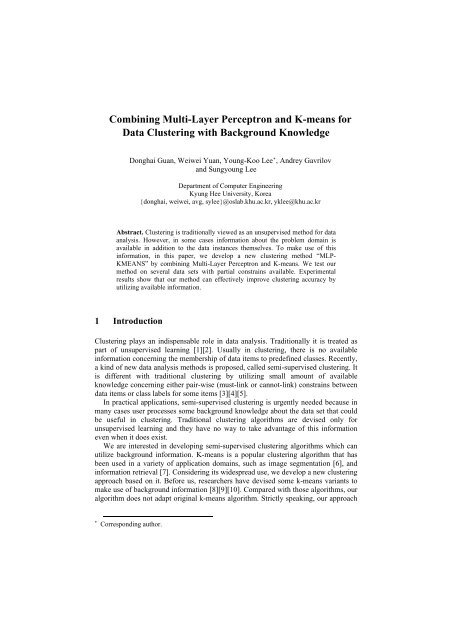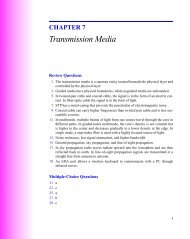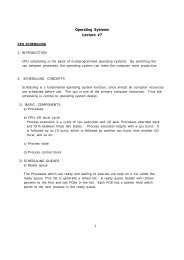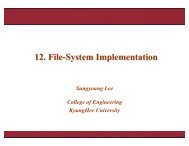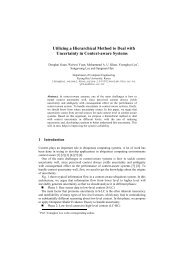Combining Multi-Layer Perceptron and K-means for Data Clustering ...
Combining Multi-Layer Perceptron and K-means for Data Clustering ...
Combining Multi-Layer Perceptron and K-means for Data Clustering ...
You also want an ePaper? Increase the reach of your titles
YUMPU automatically turns print PDFs into web optimized ePapers that Google loves.
<strong>Combining</strong> <strong>Multi</strong>-<strong>Layer</strong> <strong>Perceptron</strong> <strong>and</strong> K-<strong>means</strong> <strong>for</strong><br />
<strong>Data</strong> <strong>Clustering</strong> with Background Knowledge<br />
Donghai Guan, Weiwei Yuan, Young-Koo<br />
*<br />
LeeF F, Andrey Gavrilov<br />
<strong>and</strong> Sungyoung Lee<br />
Department of Computer Engineering<br />
Kyung Hee University, Korea<br />
{donghai, weiwei, avg, sylee}@oslab.khu.ac.kr, yklee@khu.ac.kr<br />
Abstract. <strong>Clustering</strong> is traditionally viewed as an unsupervised method <strong>for</strong> data<br />
analysis. However, in some cases in<strong>for</strong>mation about the problem domain is<br />
available in addition to the data instances themselves. To make use of this<br />
in<strong>for</strong>mation, in this paper, we develop a new clustering method “MLP-<br />
KMEANS” by combining <strong>Multi</strong>-<strong>Layer</strong> <strong>Perceptron</strong> <strong>and</strong> K-<strong>means</strong>. We test our<br />
method on several data sets with partial constrains available. Experimental<br />
results show that our method can effectively improve clustering accuracy by<br />
utilizing available in<strong>for</strong>mation.<br />
1 Introduction<br />
<strong>Clustering</strong> plays an indispensable role in data analysis. Traditionally it is treated as<br />
part of unsupervised learning [1][2]. Usually in clustering, there is no available<br />
in<strong>for</strong>mation concerning the membership of data items to predefined classes. Recently,<br />
a kind of new data analysis methods is proposed, called semi-supervised clustering. It<br />
is different with traditional clustering by utilizing small amount of available<br />
knowledge concerning either pair-wise (must-link or cannot-link) constrains between<br />
data items or class labels <strong>for</strong> some items [3][4][5].<br />
In practical applications, semi-supervised clustering is urgently needed because in<br />
many cases user processes some background knowledge about the data set that could<br />
be useful in clustering. Traditional clustering algorithms are devised only <strong>for</strong><br />
unsupervised learning <strong>and</strong> they have no way to take advantage of this in<strong>for</strong>mation<br />
even when it does exist.<br />
We are interested in developing semi-supervised clustering algorithms which can<br />
utilize background in<strong>for</strong>mation. K-<strong>means</strong> is a popular clustering algorithm that has<br />
been used in a variety of application domains, such as image segmentation [6], <strong>and</strong><br />
in<strong>for</strong>mation retrieval [7]. Considering its widespread use, we develop a new clustering<br />
approach based on it. Be<strong>for</strong>e us, researchers have devised some k-<strong>means</strong> variants to<br />
make use of background in<strong>for</strong>mation [8][9][10]. Compared with those algorithms, our<br />
algorithm does not adapt original k-<strong>means</strong> algorithm. Strictly speaking, our approach<br />
*<br />
Corresponding author.
is not a k-<strong>means</strong> variant. It is a model which combines <strong>Multi</strong>-<strong>Layer</strong> <strong>Perceptron</strong> <strong>and</strong> k-<br />
<strong>means</strong> <strong>for</strong> data clustering.<br />
In the next section, we will provide the <strong>for</strong>m of background knowledge used in our<br />
method. In Section 3, we will present in detail about our clustering method. Then we<br />
describe our evaluation method in Section 4. Experimental results are shown in<br />
Section 5. Finally, Section 6 consists of conclusions <strong>and</strong> future works.<br />
2 Background Knowledge <strong>for</strong> <strong>Clustering</strong><br />
In semi-unsupervised clustering, background knowledge refers to the available<br />
knowledge concerning either pair-wise (must-link or cannot-link) constrains between<br />
data items or class labels <strong>for</strong> some items. In current work, we will focus on using<br />
constrains between data items. Two types of pairwise constrains will be considered:<br />
• Must-link constrains specify that two instances have to be in the same cluster.<br />
• Cannot-link constrains specify that two instances must not be placed in the same<br />
cluster.<br />
Must-link <strong>and</strong> Cannot-link are Boolean function. Assuming S is the given data set<br />
<strong>and</strong> P , Q are data instances, PQ , ∈ S . If P <strong>and</strong> Q belong to same<br />
class, Must − link( P, Q)<br />
= True . Otherwise, Cannot − link( P, Q)<br />
= True . Table 1<br />
shows that pairwise constraints have two properties: symmetric <strong>and</strong> transitive.<br />
Table 1. Properties of pairwise constraints<br />
Symmetric: if PQ , ∈ S,<br />
Must −link( P, Q) ⇔ Must − link( Q, P)<br />
Cannot −link( P, Q) ⇔ Cannot − link( Q, P)<br />
Transitive: if PQR , , ∈ S,<br />
Must −link( P, Q)&& Must −link( Q, R) ⇒ Must − link( P, R)<br />
Must −link( P, Q)&& Cannot −link( Q, R) ⇒ Cannot − link( P, R)<br />
3 MLP-KMEANS<br />
3.1 K-<strong>means</strong> <strong>Clustering</strong><br />
K-<strong>means</strong> clustering [11] is a method commonly used to automatically partition a data<br />
set into k groups. It proceeds by selecting k initial cluster centers <strong>and</strong> then iteratively<br />
refining them as follows:<br />
1. Each instance di<br />
is assigned to its closest cluster center.
2. Each cluster center C<br />
j<br />
is updated to be the mean of its constituent instances.<br />
The algorithm converges when there is no further change in assignment of<br />
instances to clusters. In this work, we initialize the clusters using instances chosen at<br />
r<strong>and</strong>om from the data set. The data sets we used are composed solely of numeric<br />
features. Euclidean distance is used as measure of similarity between two data<br />
instances.<br />
Table 2. MLP-KMEANS<br />
Algorithm: MLP-KMEANS<br />
Input: data set D must-link constrains<br />
cannot-link constrains<br />
Output: Partitions of instances in D<br />
C m − link<br />
⊆ D×<br />
D<br />
Cno−link<br />
⊆ D×<br />
D<br />
Stage 1: K-<strong>means</strong> clustering<br />
1. Let C1 ... C<br />
k<br />
be the initial cluster centers.<br />
2. For each point di<br />
in D , assign it to the closet cluster C<br />
j<br />
.<br />
3. For each cluster C<br />
j<br />
, update its center by averaging all of the points<br />
d<br />
j<br />
that have been assigned to it.<br />
4. Iterate between (2) <strong>and</strong> (3) until convergence.<br />
5. Return{ C1... C k<br />
}.<br />
Stage 2: Violate-Constraints Test<br />
6. { C1... C k<br />
} makes new constrains Ck − m − link<br />
<strong>and</strong> C k−no−<br />
link<br />
7. For instances d i<br />
<strong>and</strong> d j<br />
, if they have consistent constrains in<br />
original <strong>and</strong> new constraints, their labels generated by K-<strong>means</strong> are<br />
thought reliable. Dr<br />
includes all the instances with reliable labels.<br />
Stage 3: MLP Training<br />
8. MLP is trained by error back propagation (EBP) algorithm.<br />
Only D r<br />
<strong>and</strong> corresponding labels are used <strong>for</strong> training.<br />
Stage 4: <strong>Clustering</strong> using MLP<br />
9. D is inputted into MLP to cluster.
3.2 <strong>Combining</strong> MLP <strong>and</strong> K-<strong>means</strong> <strong>for</strong> <strong>Clustering</strong><br />
Table 1 contains the algorithm MLP-KMEANS. The algorithm takes in a data<br />
set ( D ) , a set of must-link constraints ( Cm − link)<br />
, <strong>and</strong> a set of cannot-link<br />
constrains ( Cno − link<br />
). It returns a partition of the instances in D that satisfied all<br />
specified constrains.<br />
In MLP-KMEANS, clustering consists of four stages. In the first stage, D is<br />
partitioned by K-<strong>means</strong>. K clusters C1 ... C<br />
k<br />
are generated. The second step is<br />
Violate-Constraints test. The key idea of clustering in MLP-KMEANS is that MLP is<br />
trained using the output of K-<strong>means</strong> algorithm. So if the output of K-<strong>means</strong> clustering<br />
is not correct, MLP cannot be trained well. In turn, MLP cannot achieve high<br />
clustering accuracy. This step is used to filter out those samples whose labels<br />
generated by K-<strong>means</strong> might not be correct by violate-constraints test. Violateconstraints<br />
is Boolean function. For any two data instances PQ, , if VC( P, Q)<br />
= True ,<br />
then PQ , are though mis-clustered by K-<strong>means</strong>. In detail, new constraints are<br />
generated based on the output of K-<strong>means</strong>. We call them k-must-link constraints<br />
( Ck − m − link)<br />
<strong>and</strong> k-cannot-link constraints ( Ck − no − link)<br />
. For PQ, , VC( P, Q)<br />
= True in<br />
the following situations:<br />
1) Must −link( P, Q)&& K −Cannot − link( P, Q)<br />
= True<br />
2) Cannot − link( P, Q)&& K −Must − link( P, Q)<br />
= True<br />
After Violate-Constrains test, the instances with VC( P, Q)<br />
= False are gathered<br />
into D r<br />
.Stage 3 is MLP training using D r<br />
<strong>and</strong> corresponding labels. After training, in<br />
stage 4, MLP can be used <strong>for</strong> clustering instead of K-<strong>means</strong>.<br />
4 Evaluation Method<br />
The data sets used <strong>for</strong> the evaluation include a “correct answer” or label <strong>for</strong> each data<br />
instance. We use the labels in a post-processing step <strong>for</strong> evaluating per<strong>for</strong>mance.<br />
To calculate agreement between our results <strong>and</strong> the correct labels, we make use of<br />
the R<strong>and</strong> index [12]. This allows <strong>for</strong> a measure of agreement between two partitions.<br />
P1<br />
<strong>and</strong> P 2<br />
, of the same data set D . Each partition is viewed as a collection of<br />
n*( n− 1)/2 pairwise decisions, where n is the size of D . For each pair of points<br />
d<br />
i<br />
<strong>and</strong><br />
d j<br />
in D ,<br />
P<br />
i<br />
either assigns them to the same cluster or to different clusters.<br />
Let a be the number of decisions where<br />
d<br />
i<br />
is in the same cluster as<br />
d<br />
j<br />
in P 1<br />
<strong>and</strong><br />
in 2<br />
P . Let b be the number of decisions where the two instances are placed in<br />
different clusters in both partitions. Total agreement can then be calculated using the<br />
following equation.
a+<br />
b<br />
R<strong>and</strong> ( P1, P2)<br />
=<br />
n*( n−1)/2<br />
(1)<br />
We used this measure to calculate accuracy <strong>for</strong> all of our experiments.<br />
5 Experimental Results Using Artificial Constrains<br />
In this section, we report on experiments using three well-known data sets in<br />
conjunction with artificial-generated constrains. Each graph demonstrates the change<br />
in accuracy as more constrains are made available to the algorithm. The true value of<br />
k is known <strong>for</strong> these data sets, <strong>and</strong> we provide it as input to our algorithm.<br />
The constraints were generated as follows: <strong>for</strong> each constraint, we r<strong>and</strong>omly picked<br />
two instances from the data set <strong>and</strong> checked their labels, which are available <strong>for</strong><br />
evaluation purpose but not visible to the clustering algorithm. If they had the same<br />
label, we generated a must-link constraint. Otherwise, we generated a cannot-link<br />
constraint.<br />
The first data set is iris [13], which has 150 instances <strong>and</strong> 4 features. Three classes<br />
are represented in the data. Without any constrains, the k-<strong>means</strong> algorithm achieves<br />
an accuracy of 84%.<br />
Iris<br />
Accuracy<br />
100%<br />
95%<br />
90%<br />
85%<br />
80%<br />
75%<br />
K-<strong>means</strong> 50 100 150 200<br />
Number of constrains<br />
Fig. 1. MLP-KMEANS results on iris<br />
Overall accuracy steadily increases with the incorporation of constrains, reach 99%<br />
after 200 r<strong>and</strong>om constrains.<br />
We next turn to the Balance Scale data set [13], with 625 data instances <strong>and</strong> 4<br />
attributes. It contains three classes. In this work, we r<strong>and</strong>omly choose 20 instances <strong>for</strong><br />
each class. In the absence of constrains, the k-<strong>means</strong> algorithm achievers an accuracy<br />
of 71%. After incorporating 200 constrains, overall accuracy improves to 96%.
Balance Scale<br />
Accuracy<br />
100%<br />
80%<br />
60%<br />
40%<br />
20%<br />
0%<br />
K-<strong>means</strong> 50 100 150 200<br />
Number of constrains<br />
Fig. 2. MLP-KMEANS results on balance scale<br />
The third data set we used is soybean [13], which has 47 instances <strong>and</strong> 35<br />
attributes. Four classes are represented in the data. Without any constrains, the k-<br />
<strong>means</strong> algorithm achieves an accuracy of 84%. After 100 r<strong>and</strong>om constrains, overall<br />
accuracy can reach 99%.<br />
Soybean<br />
Accuracy<br />
100%<br />
95%<br />
90%<br />
85%<br />
80%<br />
75%<br />
K-<strong>means</strong> 50 100<br />
Number of constraints<br />
Fig. 3. MLP-KMEANS results on soybean<br />
6 Conclusions <strong>and</strong> Future Work<br />
In this paper, we propose a new data clustering method. It is a combination of <strong>Multi</strong>-<br />
<strong>Layer</strong> <strong>Perceptron</strong> <strong>and</strong> K-<strong>means</strong>. This method could make use of background<br />
in<strong>for</strong>mation in the <strong>for</strong>m of instance-level constrains. In experiments with r<strong>and</strong>om<br />
constrains on three data sets, we have shown significant improvements in accuracy.<br />
In the future, we will explore how background in<strong>for</strong>mation can be utilized in real<br />
applications. Then we will use our method in practical applications. Furthermore,<br />
background in<strong>for</strong>mation also includes other <strong>for</strong>m in addition to pairwise constrains,
such as user feedback. We need to consider how to utilize those kinds of in<strong>for</strong>mation<br />
in our method.<br />
Acknowledgement<br />
This research was supported by the MIC (Ministry of In<strong>for</strong>mation <strong>and</strong><br />
Communication), Korea, Under the ITFSIP (IT Foreign Specialist Inviting Program)<br />
supervised by the IITA (Institute of In<strong>for</strong>mation Technology Advancement).<br />
Reference<br />
[1] Xu, R., Wunsch, D.: Survey of <strong>Clustering</strong> Algorithms. In IEEE Transaction on Neural<br />
Networks, Vol. 16, (2005) 645-678<br />
[2] Jain, A.K., Murty, M.N., Flynn, P.J.: <strong>Data</strong> <strong>Clustering</strong>: A Review. In ACM Computing<br />
Surveys, Vol. 21, (1999) 264-323<br />
[3] Basu, S.: Semi-supervised <strong>Clustering</strong> with Limited Background Knowledge. In Proc. of<br />
the Ninth AAAI/SIGART Doctoral Consortium, (2004) 979-980<br />
[4] Basu, S., Arindam, B., Raymond J.M.: Semi-supervised <strong>Clustering</strong> by Seeding. In Proc. of<br />
the Nineteenth International Conference on Machine Learning (ICML), (2002) 19-26<br />
[5] Nizar, G., Michel C., Nozha B.: Unsupervised <strong>and</strong> Semi-supervised <strong>Clustering</strong>: a Brief<br />
Survey. A Review of Machine Learning Techniques <strong>for</strong> Processing <strong>Multi</strong>media Content,<br />
2004, http://www-rocq.inria.fr/~crucianu/src/BriefSurvey<strong>Clustering</strong>.pdf<br />
[6] Luo, M., Ma, Y.F., Zhang, H.J.: A Spatial Constrained K-<strong>means</strong> Approach to Image<br />
Segmentation. In Proc. of the Fourth Pacific Rim Conference on <strong>Multi</strong>media, (2003) 738-<br />
742<br />
[7] Bellot, P., Marc, E.B.: A clustering method <strong>for</strong> in<strong>for</strong>mation retrieval. Technical Report IR-<br />
0199, Laboratoire d’In<strong>for</strong>matique d’Avignon, France, (1999)<br />
[8] Wagstaff, K.: Intelligent <strong>Clustering</strong> with Instane-level Constrains. Ph.D Thesis, Cornell<br />
University, (2002)<br />
[9] Basu, S.: Comparing <strong>and</strong> unifying search-based <strong>and</strong> similarity-based approaches to semisupervised<br />
clustering. In Proc. of the 20 th International Conference on Machine Learning<br />
(ICML 2003), (2003) 42-49<br />
[10] Kiri, W., Claire, C., Seth, R., Stefan, S.: Constrained K-<strong>means</strong> <strong>Clustering</strong> with<br />
Background Knowledge, In Proc. of 18 th International Conference on Machine Learning<br />
(ICML 2001), (2001)577-584<br />
[11] MacQueen, J.B.: Some methods <strong>for</strong> classification <strong>and</strong> analysis of multivariate<br />
observations, In Proc. of the Fifth Symposium on Math, Statistics, <strong>and</strong> Probability,<br />
Berkeley, CA: University of Cali<strong>for</strong>nia Press, (1967) 281-297<br />
[12] R<strong>and</strong>, W.M.: Objective Criteria <strong>for</strong> the Evaluation of <strong>Clustering</strong> Methods, In J. of the<br />
American Statistical Association, (1971) 846-850<br />
[13] Blake, C., Merz, J.: UCI Repository of Machine Learning <strong>Data</strong>bases.<br />
http://www.ics.uci.edu/~mlearn/MLRepository.html.


